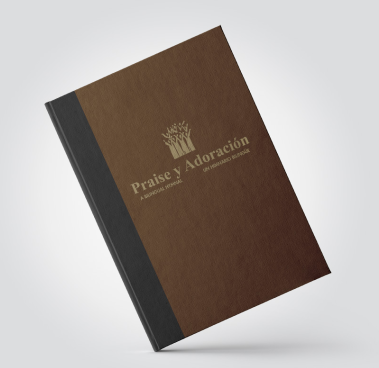Benjamín Alicea-Lugo is a church historian who has taught at New Brunswick Theological Seminary, Seminary of the East, Bethel Seminary of Bethel University, and the Florida Center for the Americas. He was the Hispanic Program Officer for the Fund for Theological Education. He teaches Spanish at Old Bridge High School and pastors St. Paul’s Evangelical Reformed Church in Perth Amboy, New Jersey. In this edited conversation, he talks about the new bilingual hymnal and worship resource he edited and published with his wife, Irma Cuevas Alicea, a licensed clinical social worker.

Why did you decide to publish a bilingual hymnal?
In the fall of 2012, St. Paul’s Church decided to combine two separate worship services into one bilingual service in English and Spanish. During the first year, we had to announce that the appropriate hymn for a particular season could only be sung in one language because we could not locate or produce a translation. The next year we began in earnest to compile hymns in two languages and expand our list of available bilingual songs outside the defined liturgical seasons.
The need to identify and publish Christian songs in two languages became a scholarly call to collect bilingual texts not only for our church in Perth Amboy, but for bilingual Christians and congregations everywhere. As bilingual, bicognitive and bicultural Christians with strong research skills, we accepted the challenge to create and publish Praise y Adoración (PyA).
An important secondary objective of the hymnal was to preserve Spanish song texts not included in more recent hymnal publications. We didn’t want them to die a slow death as out-of-print hymnals become extinct.
Why did you make your hymnal text only?
Irma and I decided to make the hymnal text only, although we both read music and play musical instruments by score and by ear. To provide the texts of 950 songs, 52 Bible readings, 15 liturgical resources and 56 pages of indexes within a 1.56-inch hardbound edition, we had to forgo musical scores. We designed an alternative, which was to identify the page numbers from up to 75 published hymnals and songbooks where the music could be found for each song. We cross-referenced 46 English, 26 Spanish and three bilingual hymnals and songbooks from 21 denominations and genres of music, as described in the hymnal end cap. With only one exception, we decided on text only so we could provide in one hardbound volume the best bilingual hymns and songs from many churches and genres of Christian music.
You said “with one exception . . .”
The one exception is a hymn called “Por la inefable luz del día/In the Amazing Light of Sunrise.” It's an example of a Spanish hymn that would become extinct if we did not republish it. Its melody and text are intrinsically beautiful. The score is on one page (which came from the out-of-print Rayos de Esperanza), and the texts are on the companion page.
So is the music for all the other hymns and coritos (short songs) available in existing hymnals?
Yes. Each song included in our hymnal had to have a musical score already published in at least one of the 75 hymnals and songbooks, and it had to have matching texts in both languages. For example, the corito “Without Him/Sin Cristo no tengo nada” is in 11 hymnals, including AAHH 515 (African American Heritage Hymnal, 515). A frequency index in the back of our hymnal identifies in descending order the number of songs available in each publication. For example, the 2008 Baptist Hymnal has music for 378 PyA texts; Himnos Majestuosos has music for 284 PyA texts; and Oramos Cantando/We Pray in Song has music for 182 PyA texts.
Where did you find hymn texts?
Published hymnals and songbooks were our primary sources for hymn texts in both languages. We needed to match the texts and the tunes in both languages from all these sources. Some sources identified the title of a hymn in the other language, while most left it to us to figure out. We regularly consulted Hymnary, the Cyber Hymnal and YouTube for help with tune recognition and other helpful information. We discovered early on that the internet was full of unreliable information and that without specific song titles, search engines could not match English and Spanish song titles.
What was your process for choosing and translating hymn texts?
Our process had many steps:
- Identify songs from multiple traditions and genres in either English or Spanish.
- Find the translation match of a song if it existed.
- Review translations to ensure there was a match in all aspects of the song.
- Locate a musical score for a translation match in an existing hymnal.
- Translate uneven verses so each language version had the same number of verses.
- Select qualified hymns which met all requirements—translation match and at least one music source in a published hymnal in both languages.
- Format qualified song to fit all texts and cross-references on one page.
- Acquire permission to include approved texts in all three PyA editions—print, app and projection.
- Complete indexes of hymnal content, sources, authors and translators.
Bilingual hymnals sometimes include text in two languages, but the verses don’t always tell the same story. How did you handle this challenge?
We found that there were two types of published translations: literal and non-literal. Literal translations were self-explanatory, and non-literal translations matched the song theme but not its lyrics. We decided to honor and include both literal and non-literal translations in our hymnal, since they had been selected by previous generations of hymnal makers. It was not our role to update or judge published translations.
We did find 51 songs with multiple published Spanish translations. Instead of choosing between two published translations and relegating one to possible extinction, we decided to keep both. In one case, we kept three translations (“Fairest Lord Jesus”). Our hymnal did translate, partially or completely, 160 hymns and coritos that are now under the copyright of Multilingual Church Media, LLC, the publisher of Praise y Adoración.
How do you use Praise y Adoración at St. Paul’s Evangelical Reformed Church?
We use all three editions of Praise y Adoración. As pastor, I carry the Android app edition on my phone and use the Kindle edition on my home office desktop. We have a supply of hymnals for use during worship, and we also use the projection edition. Some members own a copy of PyA for home use. Irma and I grew up in an inner-city church where parishioners carried a Bible and a hymnal from home to church to home. This enriched spiritual life at church, in families and in private devotions. We hope that buying PyA will help people make use of hymns and coritos to express worth to God in the closet, the war room, the green pastures of our lives or when we are surrounded by our enemies. Like the psalmist, we express our longings, triumphs and struggles in song to God, who hears us even if we cannot sing well.
How else do you hope people will use Praise y Adoración?
Ideally, a church would adopt the PyA hymnal as the local church hymnal, either as a standalone or as the companion hymnal to its denominational hymnal. The church would use the projection edition in worship and supply print editions for worshipers who are visually impaired and cannot see the screen or for worshipers in overflow rooms. Churches would also encourage members to buy a copy for home use. An unintended consequence of hymn projection is that people do not own their own hymnals for home use. God speaks through the Word, which we have both in church and at home. But when we use projection to sing our prayers in church, then we must depend on memory at home unless we own a hymnal.
Given that your abuelo (grandfather) was the founder of Puerto Rican Pentecostalism, how and why did you become pastor of a Reformed Church in America congregation?
I am an ordained Pentecostal minister received by transfer into the Classis of New Brunswick in 1979. I taught at New Brunswick Seminary from 1978 to 1985 as a Pentecostal minister. When I became the Hispanic program officer of the Fund for Theological Education, I also began pastoring the St. Paul’s Evangelical Reformed Church under the same status. I asked and received the blessing of mi abuelo, the Rev. Juan León Lugo, to serve in ministry outside the Pentecostal church. He gave me permission with one qualification: that I would leave the RCA if they “dishonored” the Holy Spirit.
LEARN MORE
You can buy Praise y Adoración in three formats: a 6-by-9-inch print edition, a downloadable app and a projection edition on flash drive. Ben will also be selling the hymnal at an exhibit at the 2017 Symposium on Worship. Connect with Pastor Ben and others interested in worshiping in English and Spanish through the Bilingual Church Group and Praise y Adoracíón Facebook pages. Learn more about Juan León Lugo, founder of Puerto Rican Pentecostalism, in this website and journal article.

